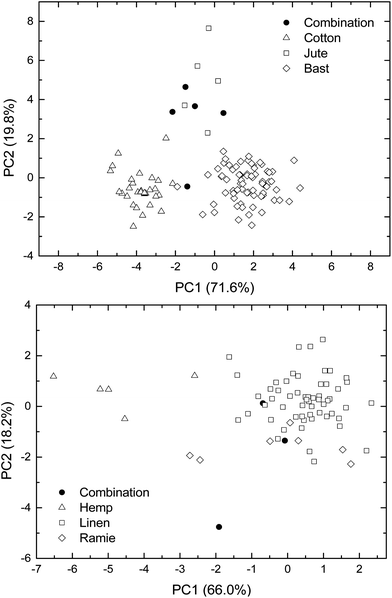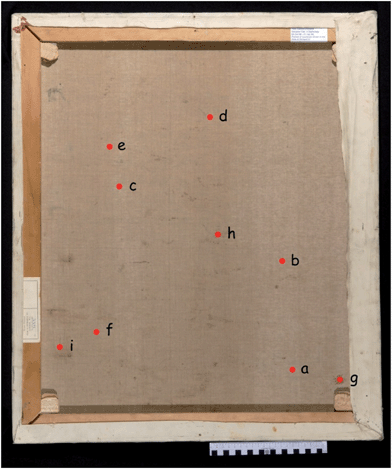 Open Access Article
Open Access ArticleCreative Commons Attribution 3.0 Unported Licence
Looking beneath Dalí's paint: non-destructive canvas analysis
Marta
Oriola
a,
Alenka
Možir
b,
Paul
Garside
c,
Gema
Campo
a,
Anna
Nualart-Torroja
a,
Irene
Civil
d,
Marianne
Odlyha
e,
May
Cassar
f and
Matija
Strlič
*f
aConservation Section, Facultat de Belles Arts, Universitat de Barcelona (UB), C/Pau Gargallo, 4, 08028 Barcelona, Spain. E-mail: martaoriola@ub.edu
bUniversity of Ljubljana, Faculty of Chemistry and Chemical Technology, Aškerčeva 5, SI-1000 Ljubljana, Slovenia
cConservation Research, The British Library, 96 Euston Road, London NW1 2DB, UK
dConservation Department, Fundació Gala-Salvador Dalí, Pujada del Castell, 28, 17600 Figueres, Spain. E-mail: irenecivil@fundaciodali.org
eSchool of Biological and Chemical Sciences, Birkbeck College, University of London, Malet Street, Bloomsbury, London WC1E 7HX, UK
fUniversity College London, Centre for Sustainable Heritage, The Bartlett School of Graduate Studies, 14 Upper Woburn Place, London WC1H 0NN, London, UK. E-mail: m.strlic@ucl.ac.uk
First published on 12th September 2013
Abstract
A new analytical method was developed to non-destructively determine pH and degree of polymerisation (DP) of cellulose in fibres in 19th–20th century painting canvases, and to identify the fibre type: cotton, linen, hemp, ramie or jute. The method is based on NIR spectroscopy and multivariate data analysis, while for calibration and validation a reference collection of 199 historical canvas samples was used. The reference collection was analysed destructively using microscopy and chemical analytical methods. Partial least squares regression was used to build quantitative methods to determine pH and DP, and linear discriminant analysis was used to determine the fibre type. To interpret the obtained chemical information, an expert assessment panel developed a categorisation system to discriminate between canvases that may not be fit to withstand excessive mechanical stress, e.g. transportation. The limiting DP for this category was found to be 600. With the new method and categorisation system, canvases of 12 Dalí paintings from the Fundació Gala-Salvador Dalí (Figueres, Spain) were non-destructively analysed for pH, DP and fibre type, and their fitness determined, which informs conservation recommendations. The study demonstrates that collection-wide canvas condition surveys can be performed efficiently and non-destructively, which could significantly improve collection management.
Introduction
Salvador Dalí i Domènech (1904–1989 Figueres, Spain) is probably the best known surrealist painter. It is also well recognised that his world was continuously influenced by contemporary scientific thinking, and his fascination with science is well documented in paintings such as Galacidalacidesoxyribonucleicacid (1963), also known as Homage to Crick and Watson (Discoverers of DNA). It is therefore perhaps befitting that his paintings are subjected to scientific analysis beyond the paint surface. The purpose of this work was to look at what the reverse of the paintings can reveal about the works of art.Due to the desire and pressure to exhibit iconic works of art, their material state and fitness to withstand handling and travel needs to be assessed. In doing so, chemical and mechanical analysis of the constituent materials of paintings is of vital importance, however, easel paintings are among the most heterogeneous works of art and an analysis of their condition is not a straightforward analytical task. Paintings are layered structures and some compounds can easily migrate from one layer to another.1 While most analytical effort is understandably dedicated to paint layers carrying the aesthetic message, surprisingly few methods exist for characterisation of their structural support, i.e. the canvas, and none are suitable for use on unique masterpieces due to their destructive nature.
Traditionally, canvas has been made of natural fibres such as linen, hemp, ramie, cotton and jute.2 These cellulosic materials are known to be sensitive to acidity of their macromolecular environment, as acids accelerate the rate of hydrolysis of glycosidic bonds in cellulose.3 Using surface water in the natural preparation of fibres leads to the macromolecular environment in the final product being neutral to slightly alkaline, which is beneficial for the stability of untreated canvas. However, application of the primer, paint, glues, and absorption of acidic gases from the environment leads to acidification of the material. Since most of these processes are heterogeneously distributed across a painted canvas, degradation proceeds in a highly heterogeneous manner and significant local differences are possible. A decrease in cellulose molecular weight (or degree of polymerisation – DP) has been shown to result in a decrease in the mechanical properties of paper4 and canvas.5 However, for painting canvases, no quantitative comparison between canvas quality and DP/pH exists, which would make it possible to interpret analytical results (the state of a material) in terms of conservation condition6 of a piece of canvas. At present, the latter can only be performed empirically,7 as degraded canvases are generally discoloured and have low flexibility, at which point a costly conservation intervention may already be required.
In addition to the two chemical properties crucial for the chemical and mechanical stability of canvas, it is also important to know the fibre type used in canvas production. Namely, the raw material importantly influences the hygrothermal response of a canvas, which is of key importance when interventions are considered.
Several methods have found use in studies of hygrothermal/mechanical properties of real painting canvases, among which particularly electronic speckle pattern interferometry8,9 and uniaxial and biaxial tensile testing10,11 have led to a detailed understanding of how the structural properties of a painting support and of the applied paint layers affect the properties of the composite material. Richardson et al.12 reviewed a number of further analytical techniques for non-destructive canvas and textile analysis, including polarised ATR FTIR, spectra of which have been shown to reflect mechanical strength of silk fibres.13 However, many of these techniques require sampling and/or laboratory-based analytical techniques.
For extremely valuable objects, such as Dalí's masterpieces, destructive sampling is not an option, and development of analytical methods enabling collection managers to assess the condition of objects can only be carried out non-destructively. Near-infrared (NIR) spectroscopy in the region 1100–2500 nm in conjunction with multivariate analysis has been shown as a particularly useful technique in characterisation of artwork supports, both for spot analysis14,15 and as an imaging application.16 It is non-destructive (and could also be classified as non-invasive), it requires no sample preparation and can be used outside the typical laboratory environment without compromising the quality of analytical data. The NIR region is of particular interest also because it reflects combination and higher harmonic oscillations of C–H, N–H, C–O and other similar bonds, mainly present in organic materials.17 However, since individual peaks strongly overlap, multivariate data analytical techniques are necessary to extract useful chemical information.18
Among these techniques, partial least square regression (PLS) is of particular interest,12,14–16,19 as it is possible to correlate spectral information with the information obtained by reference analytical methods, thus developing quantitative predictive models that can be used on similar, but unknown samples. If qualitative data is available, classification of samples is often attempted using discriminant analysis (DA), where spectra are classified based on their similarity into defined sample classes.20 Again, the method can be used in a predictive manner to classify similar, but unknown samples. For PLS and DA to yield reasonably successful predictions, high quality of the reference analytical data and validation are essential.
Significant research has been carried out on silk samples, showing that tensile strength of can be modelled using NIR/PLS.12,21 In this work, we attempted to develop PLS models using real historic canvases, hence substantial sampling for the purpose of mechanical testing was not an option. Therefore, methods were developed for determination of pH and DP of painting canvases, and based on the analysis of an extended collection of historical canvas samples, PLS and DA methods were developed using NIR spectroscopy for non-destructive determination of acidity, DP, and fibre composition of a collection of paintings by Salvador Dalí from the Fundació Gala-Salvador Dalí from Figueres, Spain. A highly interdisciplinary method of interpretation of the analytical data was also developed to provide meaningful results to those entrusted with care for the unique masterpieces.
Materials and methods
Reference collection and sampling
A collection of sacrificial historic canvas samples was assembled in collaboration with three institutions: Museu Nacional d'Art de Catalunya (MNAC), Coŀlecció de la Facultat de Belles Arts (Universitat de Barcelona, UB), Centre de Restauració de Béns Mobles de Catalunya (CRBMC) and through donations, all from the 19th to the 20th century, with a few with production dates between 16th and 18th century and some contemporary ones. Authentic canvas samples of ∼1 cm2 were taken from not visible canvas edges of paintings that are not used in displays, and further samples were historic canvas linings as well as a few contemporary textiles. For pH determination, less sample was needed and individual threads could be sampled. The total collection of reference samples thus consisted of 149 samples of painting canvases, 29 linings, 7 samples, which have in the past undergone a deacidification treatment, and 14 new textiles, 199 in total.Determination of pH
A modified micro-pH determination procedure22 with an IQ-160 ISFET pH-meter with the pHW47-SS probe (Loveland, US) was used. 250–350 μg of a sample thread was soaked overnight in 100 μL distilled water in a 1.5 mL vial, and after the period of extraction, the pH of the extract was measured. Two to three measurements were taken for each sample. The typical measurement uncertainty was 0.3 pH units.Determination of DP
The viscometric method23 was used to determine the DP of cellulose. Although sample consumption is considerable (∼30 mg), local heterogeneity is thus avoided leading to lower uncertainty. DP was calculated from intrinsic viscosity [η], using the following equation:24| DP0.85 = 1.1[η]. |
Several methods of sample preparation were tested, as viscometry has not been used for determination of the DP of such a variety of real canvas samples before. If present, the primer layer was manually removed, following which the samples were soaked and washed to remove gelatine, dried and defibred. The DP of 95 samples was determined.
Fibre identification
Polarised optical microscopy was used to identify fibres according to morphological features.25,26Panel assessment of canvas condition
35 canvases with DP ranging from 250 to 8300 were divided in pieces of 1.5 × 6 cm to produce a total of 187 samples for assessment by conservation experts. Each of the 17 experts assessed ∼11 samples according to identical instructions. A piece of canvas had to be manually pulled at 90° over the edge of a table as if it had to be tacked to a stretcher (i.e. wooden painting frame), a process conservators are most familiar with. The condition was categorised as:(1) Very fragile canvas, it cannot be re-stretched without reinforcement.
(2) Fragile canvas, re-stretching might lead to tearing.
(3) Somewhat fragile canvas, re-stretching can be done carefully.
(4) Canvas in good condition.
In the context of paintings transportation for exhibitions, it would not be advisable to loan those in the first category, since the canvas may not be able to withstand vibrations that transportation implies.
To produce a larger variety of DP values for this part of the study, a number of canvas samples were degraded at 90 °C, 65% RH (Vötsch VC 0020).
NIR spectroscopy
To collect NIR reflectance spectra a LabSpec 5000 spectrometer (Analytical Spectral Devices, USA) was used, configured with three separate holographic diffraction gratings with three separate detectors: a 512-element silicon photo-diode array detector for the spectral region 350–1000 nm, and two TE-cooled, extended range InGaAs photo-diodes for spectral regions 1000–1800 nm and 1800–2500 nm. The spectra were measured with an accessory produced specifically for the purpose of minimisation of any risk to the artworks during measurement. The accessory allows for collection of spectra in the 45°/45° geometry (spot diameter ca. 2 mm), using a 1 m fibre-optics jumper cable to interface with the LabSpec instrument. The spectra were measured over the range 1000–2250 nm, using 200 scans. The sampling interval was 2 nm, while the spectral resolution was 6 nm.Different backgrounds were used during collection of spectra of samples, depending on what was assessed as safe by conservators: a spectralon 99% reflective standard (Labsphere, North Sutton, NH, also used as a white reference for instrument calibration) or several layers of pure cellulose paper. In some cases, no background was allowed if the paint layer was considered to be fragile. Therefore, testing was necessary to ensure that different backgrounds did not affect the quality of spectra and thus the modelled results. This was done using three sample canvases from the reference collection, three paintings from the Conservation Section of the University of Barcelona, and four paintings from the Dalí collection. The modelled pH and DP values obtained from spectra with different backgrounds were compared and the standard deviation of 3–5 measurements was always less than the error of prediction, leading to the conclusion that the background has no statistically significant influence on the modelled result. This is not surprising since it was estimated that the depth from which radiation is reflected and information is obtained, is ca. 0.5 mm14, and all canvases are thicker than that. During measurements, relative humidity of the environment was 40–65%.
Three NIR spectra were collected per analysed spot and averaged using GRAMS 8.0 software (Thermo Scientific) to reduce the sampling error.
Multivariate data analysis
The purpose of multivariate data analysis was to build models to predict canvas properties from NIR spectra in order for non-destructive analysis to replace the destructive analytical methods used on reference samples.Several algorithms were used to analyse experimental results: PLS (partial least squares regression), DA (discriminant analysis) and Mahalanobis distance function (MDF).27,28 The PLS spectral decomposition technique29 was used to correlate pH and DP of canvases with NIR spectra (Grams 8.0). Separate calibration models were generated for each property. Various spectral pre-treatments were used, although multiplicative scatter correction (MSC) for reduction of the scatter effect, standard normal variate (SNV) with detrending, and differentiation using Gap algorithm (1st derivative)30,31 produced the most satisfactory results. Optimisation of the calibration process was achieved using the leave-one-out cross validation procedure and corresponded to the number of latent factors resulting in the lowest root mean squared error of cross validation (RMSECV). The model accuracy was assessed separately using the root mean squared error of prediction (RMSEP) with a validation set of samples separate from the calibration set.
To test whether the spectrum of an unknown sample (painting) was sufficiently similar to the spectra of the reference collection to give predictions of acceptable accuracy, we used PCA/MDF.32 The method combines PCA scores and spectral residuals, and uses them for Mahalanobis group matrix calculations. By including the sum squared spectral residual as a discriminating factor, the maximum allowed variation was set, which is important in the application of the PLS method to Dalí canvases, as this way outliers could be identified, for which the predictions were considered to be too unreliable.
To predict the fibre identity in Dalí canvases, which is of importance to conservation interventions, DA20 was used (XLSTAT, Addinsoft). Using this method, linear combinations of variables (spectral data) are sought for, which separate classes of objects into cotton, hemp, linen, ramie, or jute-containing, or combinations of these. The spectral region used was 1000–2250 nm. All predictor variables were considered to be of equal weight. For each Dalí painting, predictions were calculated for several analysed spots assuming that the whole canvas was of a uniform composition. It was established that two subsequent DA stages were necessary: in the first stage cotton, jute, bast (i.e. all except jute) fibres and combinations of these were distinguished. In the second stage, the samples identified as bast fibres were analysed to distinguish between linen, hemp, ramie and combinations of these.
Furthermore, Principle Component analysis (PCA) was used (XLSTAT, Addinsoft) to visualise the analytical data modelled for Dalí canvases (fibre ID, pH and DP), and painting date, to look for correlations between these parameters.
Dalí paintings
Twelve paintings from the Fundació Gala-Salvador Dalí were analysed using NIR spectroscopy (Table 1). The selection spans Dalí's life with 2–3 paintings per decade, thus providing a small-scale survey of the overall state and condition of his paintings.| FGSD Reg. no. | Date | Image | Title and observations on the canvas |
|---|---|---|---|
| a thought to be a later copy, although signed as 1947. | |||
| 0020 | 1924 |
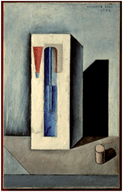
|
Siphon with Small Bottle of Rum (Cubist Painting) Canvas with a large stained area at the bottom due to a past conservation treatment |
| 0023 | 1926 |
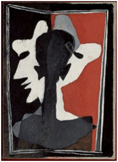
|
Self-Portrait Splitting into Three Canvas with stains due to migration of adhesives/varnishes applied to the paint layer |
| 0335 | 1926 |
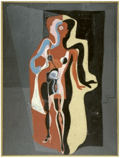
|
Barcelona Mannequin Painted on the reverse side and some areas left unpainted, therefore canvas exposed to the light |
| 0369 | 1935 |

|
Figure and Drapery in a Landscape Canvas homogeneous |
| 0336 | 1938 |

|
The Image Disappears Canvas with discoloured areas, reasons unknown |
| 0378 | 1945 |

|
Napoleon's Nose, Transformed into a Pregnant Woman, Strolling His Shadow with Melancholia amongst Original Ruins Darker areas due to the preparation procedure |
| 0053 | 1947a |

|
Backdrop for the Ballet "Labyrinth" |
| 0340 | 1947 |

|
Dematerialization Near the Nose of Nero Canvas homogeneous |
| 0058 | 1954 |

|
Gala Contemplating the Corpus Hypercubicus Canvas with stained areas |
| 0372 | 1955 |

|
Portrait of Laurence Olivier in the Role of Richard III Canvas with discoloured darker areas due to the preparation procedure, and with stains of unknown origin |
| 0066 | 1960 |

|
Gala Seen from Behind Looking in an Invisible Mirror Half of the canvas of a darker colour due to the preparation procedure |
| 0071 | c.1968 |

|
Study for The Hallucinogenic Toreador Canvas with darker areas due to the preparation procedure |
Results and discussion
NIR spectra of cellulosic materials have been discussed in several publications14,33 and the spectra of painting canvases show the same features as discussed in previous studies. However, in order to develop a non-destructive NIR method, a reliable set of analytical data obtained on reference canvas samples similar to the unknowns (Dalí paintings) was required. The reference set of samples covered the same period of time and thus covers the variability expected in the unknowns. Potentiometry was used to determine the pH of reference samples, viscometry was used to determine the DP and microscopic morphological analysis was used to identify the type of fibre.Development of NIR methods
The reference canvas samples, for which pH was determined destructively, were randomly divided into two groups: 127 samples constituted the calibration set and 43 samples constituted the validation set. The same was done for determination of DP: 70 samples constituted the calibration set and 32 were used for validation.In fibre analysis, it turned out that 2 canvases contained synthetic fibres, so that their classification as outliers was justified from the point of view of fibre content. More samples were available for pH determination since the reference method requires a smaller sample than for DP determination, hence different sample sets used.
For the PLS method of pH determination, the best validation results were obtained by mean-centring of spectra, followed by 1st derivation (Gap, 9 points), standard normal variate detrending, and 9 factors were used. For the DP method, the spectra were mean centred, followed by 1st derivation (Gap, 11 points) and standard normal variate detrending, with 14 factors. Also, this method gave better results if the water peak was disregarded, so the spectral region used in PLS regression consisted of 1200–1870 and 2000–2250 nm, which was different to the pH PLS method, which made use of the full spectral interval.
The developed PLS methods (Fig. 1) indicate that there are satisfactory correlations between modelled and measured values. The RMSEP values of ±0.43 pH units and ±275 DP units were to be expected, given that historical canvases not only contain the already heterogeneous natural textile impregnated with natural glue, but often also primer, oil and varnish penetrating from the upper layers of the painting. The RMSEP value of 0.43 pH units is comparable with the measurement uncertainty of the reference method, which is 0.3 pH units.
Viscometric DP determination is an accurate method with a typical uncertainty of <1%, although for heterogeneous historic canvas samples, typical measurement uncertainties for triplicate determinations were up to 10%, while the standard error of prediction of 275 represents approximately ∼20% uncertainty in the middle range of DP values. The uncertainties of PLS methods are thus only approximately twice as high as the corresponding uncertainties of the reference methods, which is considered to be successful given the significant heterogeneity of samples.
On the basis of the reference set of samples analysed for fibre content, two-stage linear discriminant analysis was performed using spectral data in the interval 1500–2250 nm. In the first stage, separation between ‘cotton’, ‘bast’ (hemp, linen, ramie, or linen and hemp), ‘jute’ (also a bast fibre but can be confidently identified using microscopy) and ‘combinations’ (jute and cotton, jute and ‘bast’, ‘bast’ and cotton) was attempted.
Namely, warp and weft threads were sometimes made of different fibres, and sometimes threads made of a mixture of fibres were used, in which case the measured NIR spectrum would represent a mixture of individual spectra of the two fibre types, as the measurement spot was Ø2 mm. Several such mixed-thread canvases were determined. To build the method 113 samples were used, and 60 were used for validation. In the second stage, only the ‘bast’ category fibres were taken into account from the first stage, 73 to build the method and 38 to validate it. These were grouped into four further categories: ‘linen’, ‘hemp’, ‘ramie’ and ‘combination’ of linen and hemp.
A very satisfactory separation into the three easily identifiable main groups of natural fibres was obtained (Fig. 2, top), which is probably based on the fact that cotton, jute and bast fibres can easily be differentiated using an optical microscope. According to the confusion matrix (Table 2), cotton and also bast (linen, hemp or ramie) samples can be classified with high confidence, while the less populated groups of jute and combination fibres are classified 50–67% correctly. Not surprisingly, combination fibres can be classified as either pure fibre as well. Undoubtedly, the reason for the less successful classification of these fibres is the fact that there were only a small number of canvases available made of jute and combinations jute/cotton, jute/linen, linen/cotton and hemp/cotton.
| Known | Classified as | Total | % correct | |||
|---|---|---|---|---|---|---|
| B | Cb | Ct | J | |||
| Stage 1 | ||||||
| Estimation | ||||||
| B | 72 | 0 | 1 | 0 | 73 | 99% |
| Cb | 0 | 4 | 1 | 0 | 5 | 80% |
| Ct | 0 | 0 | 30 | 0 | 30 | 100% |
| J | 0 | 0 | 0 | 5 | 5 | 100% |
| Total | 72 | 4 | 32 | 5 | 113 | 98% |
| Validation | ||||||
| B | 35 | 0 | 3 | 0 | 38 | 92% |
| Cb | 0 | 2 | 1 | 1 | 4 | 50% |
| Ct | 0 | 0 | 15 | 0 | 15 | 100% |
| J | 1 | 0 | 0 | 2 | 3 | 67% |
| Total | 36 | 2 | 19 | 3 | 60 | 90% |
| Known | Classified as | Total | % correct | |||
|---|---|---|---|---|---|---|
| Cb | H | L | R | |||
| Stage 2 | ||||||
| Estimation | ||||||
| Cb | 1 | 0 | 2 | 0 | 3 | 33% |
| H | 0 | 5 | 0 | 0 | 5 | 100% |
| L | 0 | 0 | 58 | 0 | 58 | 100% |
| R | 0 | 0 | 4 | 3 | 7 | 43% |
| Total | 1 | 5 | 64 | 3 | 73 | 92% |
| Validation | ||||||
| Cb | 0 | 0 | 2 | 1 | 3 | 0% |
| H | 0 | 2 | 1 | 0 | 3 | 67% |
| L | 2 | 2 | 21 | 3 | 28 | 75% |
| R | 0 | 1 | 2 | 1 | 4 | 25% |
| Total | 2 | 5 | 26 | 5 | 38 | 63% |
In the second phase, sub-grouping of samples identified as ‘bast’ in the first phase was attempted (Fig. 2, bottom). Considering that it is often difficult to reliably identify the individual fibre types in this group and considering that most of the bast canvases were made of linen, the lower success of the second-stage DA is not surprising. None of the combinations were correctly identified, while identification of linen and hemp was reasonably successful. To increase the success of the second stage DA, more of reliably identified hemp and ramie canvases would be needed.
It needs to be stressed that the validity of the developed NIR methods is limited to canvases that are similar to those in the reference collection, i.e. mainly 19th and 20th-Century canvases, with no synthetic fibres, and with a primer layer. The validity of the method has not been tested for extremely soiled or mould-infested canvases and it is likely that the PLS and DA methods would not give reliable results for such materials.
Analysis of Dalí paintings
Using the methods as developed above, spectra of canvases from the collection of the Fundació Gala-Salvador Dalí were collected in situ and non-destructively. Measurement points were selected on the basis of whether the canvases exhibited discoloured or stained (Table 1). The latter could come from penetration of paint materials through the canvas layer, from conservation interventions, or from localised degradation. Unfortunately, no DP predictions were obtained for 23 out of the 123 spectra (22.7%), as the Mahalanobis distance was too large and thus the prediction too unreliable. In Table 3, these examples are identified with ‘n/a’.| Reg. no | Sampling area | pH | DP | Fibre ID1 | Fibre ID2 | Date |
|---|---|---|---|---|---|---|
| 0020 | Canvas (n = 5) | 5.7 | n/a | Ct (100%) | — | 1924 |
| Stained area (n = 4) | 5.8 | n/a | ||||
| 0023 | Canvas (n = 3) | 5.7 | 550 | Ct (64%), B (36%) | — | 1926 |
| Stained area no. 1 (n = 3) | 5.7 | 350 | ||||
| Stained area no. 2 (n = 3) | 5.5 | 700 | ||||
| 0335 | Canvas (n = 4) | 5.3 | n/a | Ct (100%) | — | 1926 |
| 0369 | Canvas (n = 15) | 5.1 | 1500 | B (51%), J (44%) | L (98%), R (2%) | 1935 |
| 0336 | Canvas (n = 15) | 5.2 | 800 | B (100%) | L (78%), R (22%) | 1938 |
| Discoloured area (n = 3) | 5.0 | 750 | ||||
| 0378 | Canvas (n = 15) | 5.2 | 800 | B (100%) | L (99%), R (1%) | 1945 |
| Discoloured area (n = 3) | 5.2 | 600 | ||||
| Stained area (n = 1) | 5.2 | 300 | ||||
| 0053 | Canvas (n = 4) | 6.7 | n/a | Ct (100%) | — | 1947 |
| 0340 | Canvas (n = 15) | 5.6 | 1000 | B (100%) | R (52%), L (48%) | 1947 |
| 0058 | Canvas (n = 6) | 5.7 | 1030 | B (100%) | L (90%), R (10%) | 1954 |
| Stained area (n = 2) | 5.7 | 1300 | ||||
| 0372 | Canvas (n = 3) | 5.4 | 1150 | B (100%) | L (99%), R (1%) | 1955 |
| Discoloured area (n = 3) | 5.3 | 1050 | ||||
| Stained area (n = 3) | 5.4 | 850 | ||||
| 0066 | Canvas (n = 3) | 5.8 | 1400 | B (100%) | L (94%), R (6%) | 1960 |
| Discoloured area (n = 3) | 5.8 | 1200 | ||||
| 0071 | Canvas (n = 3) | 6.0 | 1350 | B (100%) | L (99%), R (1%) | 1968 |
| Discoloured area (n = 3) | 5.7 | 1150 | ||||
| Stained area (n = 1) | 5.9 | 1350 |
The data in Table 3 indicates clearly identifiable differences between the canvases. In the first-step DA, most canvases have been identified as ‘cotton’ or ‘bast’ (i.e. bast fibres except jute) with considerable certainty (Table 2). Only two canvases represent uncertain cases: for Reg. no. 0023 there is a significant possibility for the material not to be cotton, which might indicate the possibility of the canvas being a combination of cotton and bast fibres, although the possibility of a combined-fibre canvas was not flagged up at this stage. Reg. no. 0369 is another example of uncertain identification, the canvas could be either ‘bast’ or ‘jute’ (or a combination). Since there was a slightly higher possibility for this canvas to be of a ‘bast’ fibre, this canvas was also analysed in the second-stage DA.
Jute canvases are probably the only ones that can be quite confidently identified by visual observation. Similarly, when canvases have one of the threads made of jute, the difference between the warp and the weft can easily be spotted with the naked eye. Finally, whereas hemp and linen or cotton and synthetic fibres have traditionally been mixed to produce “mixed threads”, we have not come across any canvas where jute fibres have been mixed with other fibres to produce such mixed threads. For all these reasons, it is likely that there is probably no jute present in Reg. no. 0369 and that it is indeed a linen canvas, as the second-stage DA indicates. On top of this, a commercial Lucient Lefebvre–Foinet stamp was identified on the reverse of this painting in the course of this research (reading “Toiles & Couleurs/Extrafines/Lucien Lefebvre–Foinet/Paris/19, Rue Vavin & 2, Rue Brèa”), which would indicate the canvas is a good quality linen support from the well-established French artists' materials company (this painting has the highest DP value of all: 1500, despite its age). This perfectly corresponds with the period when Dalí was living in Paris, when he would get his materials in French local shops.34
The second-stage DA method clearly exhibits difficulties in discriminating between linen and ramie, as also indicated by the confusion matrix (Table 2), where in the validation phase most misidentified ramie fibres were classified as linen and some also vice versa. It is therefore reasonable to expect to have similar difficulties with the real canvases. Samples, which were identified as linen with less than 90% probability are Reg. no. 0340, which could be either ramie or linen, and Reg. no. 0336, which is most probably linen. It is worth stressing again that microscopic identification of ramie fibres is itself uncertain, which is why DA should be interpreted with caution.
Looking at the oil paintings (i.e. disregarding Reg. no. 0053, which is a 9 × 13 m theatre backdrop, 1947), the three that are painted on cotton (the cheapest support to paint on) are all from Dalí's student days in Madrid (1922–1926). In his maturity, he is known for having always sought good quality materials (i.e. linen supports)34 and so the use of cotton in the early days can be linked to the very experimental period of the young artist.35 Dalí returns to using cheap cotton supports only in his very last days, after Gala's passing and the person in charge of supplies seemed not to care as much about their quality.34
The acidity of canvases is not significantly different, except for one almost neutral and thus stable canvas (pH 6.7), and Reg. no. 0336, which has a local area that is significantly more acidic than other (pH 5.0). These results are in line with the canvas pH values found in other paintings analysed.36 Increased acidity is a significant problem for long-term preservation of canvases due to decreased chemical stability of cellulose.3
However, there are significant differences in the DP. From among the non-stained canvases, there is one, which is particularly degraded (DP < 600), Reg. no. 0023. Three others (Reg. nos. 0336, 0378 and 0340) have midrange DP values (600–1000), while the majority are in a very good condition with DP values >1000. Six of the analysed paintings had stains on the canvas caused by oil, varnish or adhesives, which were also analysed to see if the canvas was more degraded in these areas. In half of the instances this was actually the case, while in other cases the stains may have protected the base material.
On the other hand, five of the analysed Dalí paintings were found to have discoloured darker canvas areas that were thought to be the result of the application of an industrial preparation layer since they tended to follow a regular pattern (broad darker and lighter stripes, Fig. 3). In all these paintings, the discoloured darker areas had a lower DP than in the non-discoloured areas, which would indicate that migration of components present in the preparation layers, such as oils, might have promoted the degradation of canvas.
Univariate analysis of the available data (Table 3) may not reveal any useful correlations, as the parameters (age, pH, DP, fibre ID) could be co-dependent. In Fig. 4, the loading plot is shown for PCA performed on the data in Table 3. PC1 generally separates according to extent of degradation, with the samples with better material properties (higher DP and pH) having more positive values. The loading plot reveals that higher DP values are associated with younger canvases, confirming that ageing of canvases results in lower DP. There is a weak indication that canvases with higher pH have higher DP, and that bast fibres are generally in a better state; however, due to the small number of non-bast samples and generally similar pH values of the canvases, it is difficult to expect strong correlations. On the other hand, the narrow distribution of pH values of the analysed canvases (Table 3) could also indicate that past environmental conditions, particularly acidic pollutants, might have played a role.
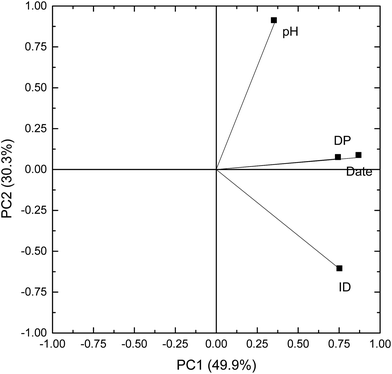 | ||
| Fig. 4 Loading plot for PCA of the data in Table 3 for all Dalí paintings (n = 11). Fibre ID as a descriptive parameter was modeled using the value of 0 for cotton and 1 for bast (linen or ramie). | ||
However, while scientific analysis is of high importance in the understanding of the material state of canvases, analytical data need to be expertly interpreted in order to assess whether there is a correlation between the analytically determined material state, and the conservation condition of a canvas.
Fitness for purpose
‘Normal use’ of a painting canvas (as hung in a gallery or in storage) involves little mechanical stress. However, prior to exhibitions canvases need to be transported and while every care is taken to avoid excessive mechanical stress, paintings need to be examined to assess the risk of physical damage during such activity. Even if in the recent decades Dalí's paintings travel less than they used to in order to minimize their deterioration,37 loans are often requested due to the artist's international recognition.While most attention is given to the integrity of the paint layer carrying the aesthetic information, the structural element, i.e. canvas, is only visually assessed for evidence of existing damage. Material characterisation methods allowing collection managers to assess the magnitude of risk of damage during loans would thus be very welcome. While acidity and fibre type are unlikely to play an important role in such assessments, it is known that for certain fibre types, DP strongly correlates with mechanical properties.38
Thus, a test was designed to investigate the correlation between DP and canvas condition, as assessed by a panel of 17 independent experts. Given the uncertainty of subjective categorisation, a surprising correlation between condition categories and DP was obtained (Fig. 5). The categories are broadly defined, which is reflected in the uncertainty; however, the uncertainty of DP prediction is comparatively small, which enables us to define categories on the basis of DP.
Undoubtedly, there are other parameters defining canvas mechanical properties, such as glue content, but given that the number of reference samples was significant and highly variable in terms of material composition, the influence of glue is evidently of lesser importance. On the other hand, the strength and adhesion of the primer and paint layers must also have an effect; however, these need to be assessed using structural assessment methods, e.g. holography.39
Data in Fig. 5 reveal that canvases with DP < 600 were mostly classified into category “Very fragile canvas”, where excessive stress is not advised due to risk of physical damage. This is higher than the value 250–300, which is usually taken as the value at which paper loses all mechanical strength,40 and DP 400 which is considered to be the value at which historic paper containing iron gall ink is considered at risk.15 It is possible that in canvases better quality of fibres are required to perform the mechanical operations required to tack a canvas onto the stretcher.
Looking at the Dalí canvases in Table 3, we see that only one painting could be categorised as very fragile (Reg. no. 0023), while such low DP values could also be found in the stains of this same painting and of Reg. no. 0378, meaning these two paintings have locally significantly degraded areas. The other paintings are all in a good condition, and can safely continue to be enjoyed by Dalí enthusiasts.
Conclusions
A wide-ranging study of canvases from the historic reference canvas collection at University of Barcelona was performed. pH, DP and fibre composition was determined for 199 samples mostly ranging from the 19th and 20th centuries. The collected data was used in conjunction with NIR spectroscopy and multivariate data analysis to develop quantitative PLS methods to non-destructively determine pH and DP of real canvases, and DA classification methods to non-destructively determine the fibre type. To interpret the analytical data, a classification method was developed in collaboration with a panel of conservators. Using these methods, a survey of 12 painting canvases by Dalí was carried out. The following conclusions can be made:• The developed PLS methods for the prediction of the canvas pH and DP are considered to be very satisfactory given the heterogeneity of the samples, with RMSEP values ±0.43 units for pH and ±275 units for DP.
• A two-stage DA method was developed, the first-stage DA reliably distinguishing between ‘cotton’, ‘jute’ and the rest of the ‘bast’ fibres (linen, hemp, ramie or linen and hemp). The second-stage DA further distinguishes between ‘bast’ fibres, and is less reliable probably due to the fact that there are only a few hemp, ramie and linen and hemp samples available in the reference sample collection.
• A categorisation method was developed with a panel of experts, defining the ‘Very fragile’ category as the category of paintings so weak that they would not withstand canvas manipulation, such as re-stretching without tearing, and thus no longer fit for travelling either. Despite the uncertainty of subjective tests, a surprising correlation between the condition categories and DP was obtained, with the threshold DP for the ‘Very fragile’ category being 600.
• Using the non-destructive methods based on NIR spectroscopy, the pH of all the Dalí canvases was found to be between 5.0 and 6.7, while most of the canvases had DP > 1000, and only one painting with DP < 600, i.e. in the ‘Very fragile’ category.
• PCA performed with the analytical data obtained for the Dalí canvases revealed that DP decreases with age, and indicated that lower pH might accelerate the degradation process, and that cotton canvases possibly degrade faster than linen ones.
It is of interest that Dalí used the less expensive cotton canvases in the early days of his career when he was a student, and replaced them for the higher quality linen supports when his work gained recognition.
While this research was performed using a number of real canvas samples (199), most were of a geographically and temporally limited origin. To improve the applicability of the method, it would need to be validated a broader sample set of different provenance and age. The new method, involving the development and optimisation of destructive methods of chemical analysis, NIR methods, and methods of data interpretation presented here enables curators and conservators to survey the condition of painting collections and base collection management on evidence, with data obtained in an efficient and non-destructive manner. If in further studies, dose–response functions are developed for degradation of painting canvases, modelling of future degradation and predictive maintenance could be enabled.
Acknowledgements
COST Action D42, University of Barcelona, University College London, and the Slovenian Research Agency (Programme P1-0153) are gratefully acknowledged for financial support. Fundació Gala-Salvador Dalí is gratefully acknowledged for providing access to their collection. We are also grateful for sampling permissions from the following institutions and experts: MNAC (Mireia Mestre), Coŀlecció de la Facultat de Belles Arts, UB (Dolo Pulido), CRBMC (Maite Toneu). In addition to the authors of the paper, the following colleagues helped with canvas fitness tests and their assistance is gratefully acknowledged: Cecil Kraup Andersen (School of Conservation, Denmark), Anne Bacon (Northumbria University), Kenneth Bé (Gerald Ford Conservation Center), Irene Civil (Fundació Gala-Salvador Dalí), Jim Devenport (Haughton Studios), Stephen Hackney (Tate Gallery), Jean-François Hulot (Conservation consultant, France), Maite Jover and Lucía Martínez (Museo Nacional del Prado), Eun-Jin Kim (National Museum of Contemporary Art, South Korea), Núria Pedragosa (Museu Nacional d'Art de Catalunya), Erminio Signorini (Private conservator and Cesmar7, Italy), Eileen Sullivan (Cleveland Museum of Art), Maite Toneu, Pau Claramonte and Nadir López (Centre de Restauració de Béns Mobles de Catalunya), Christina Young (Courtauld Institute of Art). The commercial Lucien Lefebvre-Foinet stamp of Reg. no. 0369 was identified with kind assistance by Dr Núria Pedragosa (Painting conservator at MNAC). All images ©Salvador Dalí, Fundació Gala-Salvador Dalí, VEGAP, 2013.Notes and references
- J. J. Boon, F. Hoogland and K. Keune, 34th Annual meeting of the AIC of Historic & Artistic Works providence, Rhode Island, 2006, postprints, 2007, vol. 19, pp. 16–23 Search PubMed.
- C. Villers, ICOM-CC 6th Triennial Meeting, Ottawa, 1981, p. 81/2/1 Search PubMed.
- Ageing and Stabilisation of Paper, ed. M. Strlič and J. Kolar, National and University Library, Ljubljana, 2005 Search PubMed.
- X. Zou, N. Gurnagul, T. Uesaka and J. Bouchard, Polym. Degrad. Stab., 1994, 43, 393–402 CrossRef CAS.
- A. M. Seves, S. Sora, G. Scicolone, G. Testa, A. M. Bonfatti and E. Rossi, Journal of Cultural Heritage, 2000, 1, 315–322 CrossRef.
- M. Strlič, D. Thickett, J. Taylor and M. Cassar, Stud. Conserv., 2013, 58, 80–87 CrossRef PubMed.
- CCI, Paintings: Considerations Prior to Travel. Canadian Conservation Institute Notes 10/15, 1993 Search PubMed.
- C. Young, Optics and Lasers in Engineering, 1999, 31, 163–170 CrossRef.
- D. Ambrosini, D. Paoletti and G. Galli, Integrated digital speckle based techniques for artworks monitoring, Lasers in the Conservation of Artworks, Proceedings of the International Conference LACONA 7, 2008, pp. 399–405.
- C. R. T. Young and R. D. Hibberd, Stud. Conserv., 1999, 44, 129–141 CrossRef.
- D. J. Carr, C. R. T. Young, A. Phenix and R. D. Hibberd, Stud. Conserv., 2003, 48, 145–154 Search PubMed.
- E. Richardson, G. Martin, P. Wyeth and X. Zhang, Microchim. Acta, 2008, 162, 303–312 CrossRef CAS.
- P. Garside, S. Lahlil and P. Wyeth, Appl. Spectrosc., 2005, 59, 1242–1247 CrossRef CAS PubMed.
- T. Trafela, M. Strlič, J. Kolar, D. A. Lichtblau, M. Anders, D. Pucko Mencigar and B. Pihlar, Anal. Chem., 2007, 79, 6319–6323 CrossRef CAS PubMed.
- M. Strlič, L. Cséfalvayová, J. Kolar, E. Menart, J. Kosek, C. Barry, C. Higgitt and M. Cassar, Talanta, 2010, 81, 412–417 CrossRef PubMed.
- L. Cséfalvayová, M. Strlič and H. Karjalainen, Anal. Chem., 2011, 83, 5101–5106 CrossRef PubMed.
- H. W. Siesler, Y. Ozaki, S. Kawata and H. M. Heise, Near-Infrared Spectroscopy. Principles, Instruments, Applications, Wiley-VCH, Weinheim, 2002 Search PubMed.
- R. Karmer, Chemometric Techniques for Quantitative Analysis, Dekker, New York, 1998 Search PubMed.
- H. Martens and T. Naes, Partial least squares regression, Mutivariate Calibration, Wiley, Chichester, 1989 Search PubMed.
- C. J. Huberty, Applied Discriminant Analysis, Wiley-Interscience, New York, 1994 Search PubMed.
- E. Richardson and P. Garside, e-Preserv. Sci., 2009, 6, 68–74 Search PubMed.
- M. Strlič, J. Kolar, D. Kočar, T. Drnovsek, V.-S. Selih, R. Susic and B. Pihlar, e-Preserv. Sci., 2004, 1, 35–47 Search PubMed.
- ISO 5351:2010, Pulps – determination of limiting viscosity number in cupri-ethylenediamine (CED) solution.
- R. Evans and A. F. A. Wallis, 4th Int. Symp. Wood Chem., 1987 Search PubMed.
- G. Campo, R. Bagan and N. Oriols, Identificació de fibres. Suports tèxtils de pintures. Metodologia, Generalitat de Catalunya, Barcelona, 2009 Search PubMed.
- The conservation of easel paintings, ed. J. H. Stoner and R. Rushfield, Routledge, New York, 2012 Search PubMed.
- H. Martens and T. Næs, Multivariate Calibration, John Wiley & Sons, Chichester, 1989 Search PubMed.
- P. M. Fredericks, J. B. Lee, P. R. Osborn and D. A. J. Swinkels, Appl. Spectrosc., 1985, 39, 303–310 CrossRef CAS.
- D. M. Haaland and E. V. Thomas, Anal. Chem., 1988, 60, 1193–1202 CrossRef CAS.
- P. Geladi, D. MacDougall and H. Martens, Appl. Spectrosc., 1985, 39, 491–500 CrossRef.
- R. J. Barnes, M. S. Dhanoa and S. J. Lister, Appl. Spectrosc., 1989, 43, 772–777 CrossRef CAS.
- H. L. Mark and D. Tunnell, Anal. Chem., 1985, 57, 1449–1456 CrossRef CAS.
- L. Cséfalvayová, M. Pelikan, I. Kralj Cigić, J. Kolar and M. Strlič, Talanta, 2010, 82, 1784–1790 CrossRef PubMed.
- G. Berini and G. Campo, 1st International Conference on Painting Conservation. Canvases: behaviour, deterioration & treatment, UPV, València, 2005, pp. 213–232 Search PubMed.
- G. Berini, Los acabados mate en la obra de Salvador Dalí, in Restaurando arte contemporáneo. Georgina Berini – Textos y testimonios, ed. G. Campo, Libros Pórtico, Zaragoza, 2009, pp. 109–128 Search PubMed.
- M. Oriola, M. Strlič, G. Campo, A. Možir, A. Nualart-Torroja and C. Ruiz-Recasens, Colour and Conservation, Il Prato, 2012,pp. 201–207 Search PubMed.
- G. Berini, La conservación de la obra de Salvador Dalí. Problemas y soluciones, Fundació Gala-Salvador Dalí, Figueres, 2000 Search PubMed.
- X. Zou, T. Uesaka and N. Gurnagul, Cellulose, 1996, 3, 243–267 CrossRef CAS.
- V. Tornari, e-Preserv. Sci., 2006, 3, 51–57 Search PubMed.
- D. H. Shroff and A. W. Stannett, IEEE Proc., 1985, 132, 312–319 Search PubMed.
| This journal is © The Royal Society of Chemistry 2014 |


